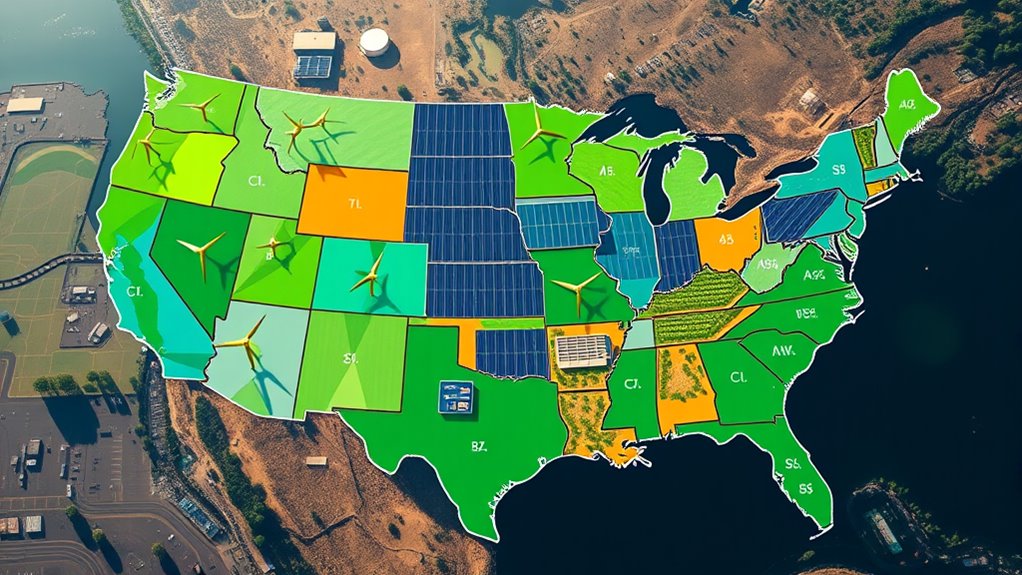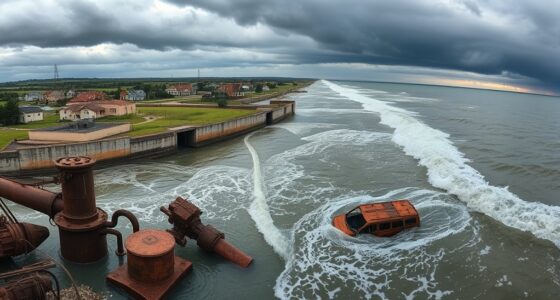In 2025, you’ll see California leading with advanced solar projects and strong incentives, while Texas continues to dominate wind energy through huge investments in transmission and vast plains. Midwest states like Iowa and Kansas harness wind power with improved turbines, and Arizona boosts solar efforts through supportive policies. Grid modernization and storage solutions strengthen reliability across regions. Keep exploring to discover how these strategies integrate to shape America’s clean energy future.
Key Takeaways
- California leads nationwide with extensive solar projects supported by strong incentives and favorable net metering policies.
- Texas dominates wind energy growth due to significant investments in transmission infrastructure and vast wind resources.
- Midwest states like Iowa and Kansas have rapidly expanded wind capacity, reducing reliance on fossil fuels.
- States such as Nevada and Arizona are increasing solar adoption through state and federal incentives.
- Grid modernization and energy storage advancements ensure reliable integration of renewables across all leading states.

By 2025, renewable energy adoption has become a defining feature of the United States’ energy landscape, with states competing to lead in sustainable power generation. You’ll notice that some states have surged ahead, driven by aggressive policies like solar incentives and innovative approaches to wind integration. These measures make renewable projects more affordable and accessible, encouraging homeowners and businesses to invest in solar panels and wind turbines. As a result, states that prioritize these incentives often see rapid growth in their renewable capacity.
By 2025, policies like solar incentives and wind strategies drive rapid renewable energy growth across US states.
In states like California and Texas, solar incentives have played a vital role in boosting adoption. California’s state-sponsored rebates and tax credits considerably lower the upfront costs of installing solar systems, making it easier for residents to go green. This push, combined with favorable net metering policies, enables homeowners to sell excess power back to the grid, fostering a more sustainable energy ecosystem. Meanwhile, Texas leads in wind integration, harnessing its vast plains and strong wind currents. The state’s grid operators have invested heavily in transmission infrastructure, allowing wind farms to connect efficiently to the grid and deliver consistent power. These efforts help Texas maintain its position as a renewable powerhouse.
Other states are catching up by focusing on a balanced mix of solar and wind resources. For instance, the Midwest has seen a boom in wind projects, thanks to improved wind turbine technology and better grid integration strategies. States like Iowa and Kansas are capitalizing on their wind potential, reducing reliance on fossil fuels and lowering emissions. Additionally, the adoption of advanced grid modernization techniques is supporting the integration of diverse renewable sources. Simultaneously, states with abundant sunlight, such as Arizona and Nevada, are ramping up solar projects, supported by state-level incentives and federal programs. These efforts not only diversify energy sources but also bolster local economies through job creation.
Across the country, policy frameworks are becoming more sophisticated, emphasizing grid modernization and storage solutions. These advancements guarantee that renewable energy, whether solar or wind, remains reliable and resilient. As you observe these developments, it’s clear that the interplay of solar incentives and wind integration strategies is shaping a more sustainable, decentralized energy system. States that invest in these areas are not just reducing carbon footprints — they’re also setting the stage for economic growth and energy independence. Additionally, the growth of cold-pressed vegetable juices and other health trends reflects a broader societal shift towards sustainability and wellness, highlighting how environmental initiatives can align with lifestyle choices. By 2025, the landscape vividly reflects a concerted effort to leverage renewable resources, driven by policies that make clean energy more accessible and integrated into everyday life.
Frequently Asked Questions
How Do Renewable Energy Policies Vary Between States?
You’ll notice that renewable energy policies vary considerably between states due to legislative differences and policy variability. Some states set ambitious renewable targets and offer incentives, while others focus less on renewables. These differences impact how quickly and extensively renewable energy develops across regions. Your understanding of these legislative differences helps you see why adoption rates differ, shaping local energy landscapes and influencing the nation’s overall progress toward sustainable energy goals.
What Are the Economic Impacts of Renewable Adoption?
While it’s often said that renewable energy adoption brings some gentle shifts, you’ll find it truly fosters economic growth and job creation. As you embrace renewables, you support local economies and encourage innovation. This changeover can lead to new industries and opportunities, boosting employment. Overall, investing in renewables not only benefits the environment but also helps strengthen your community’s economic resilience and prosperity, creating a brighter, more sustainable future for all.
Which States Have the Most Advanced Renewable Infrastructure?
You’ll find that states like California, Texas, and Iowa lead in renewable infrastructure. They’ve implemented strong solar incentives and advanced wind integration projects, boosting their renewable capacity. These states prioritize policies that support clean energy growth, making them models for others. Your focus should be on how these incentives and wind integration efforts help them expand renewable energy, creating a more sustainable and resilient grid for the future.
How Is Renewable Energy Storage Managed Across States?
Imagine your local grid humming with renewable power, seamlessly integrating solar and wind energy. You’d see grid integration at work, balancing supply and demand across states. Storage technologies like batteries and pumped hydro store excess energy for later use, ensuring stability. States coordinate these efforts through regional grids and policies, managing storage solutions efficiently. This coordinated approach keeps your lights on, even when the sun isn’t shining or the wind isn’t blowing.
What Are Future Trends in State Renewable Energy Investments?
You see that future trends in state renewable energy investments will likely focus on expanding solar subsidies and wind farm development. States are expected to increase funding and incentives to boost cleaner energy sources. You’ll notice more policies encouraging rooftop solar and larger wind projects, aiming to reduce emissions and create jobs. This shift will make renewable energy more accessible and affordable, driving significant growth in the sector over the coming years.
Conclusion
As you can see, each state is carving its own path toward a renewable future, like pieces of a puzzle fitting together. With continued innovation and commitment, you’ll witness even more progress in the years ahead. The journey to clean energy is a marathon, not a sprint, and every step counts. Stay informed and inspired—your role in this shift is essential. Together, we’re shaping a sustainable world, one state at a time.
Amina brings over a decade of journalism experience to her role as Editor-in-Chief. Under her leadership, Exquisite Post has flourished, maintaining the highest standards of integrity and excellence. Amina’s commitment to truth and her visionary approach guide the editorial team in producing impactful news stories that resonate with our audience.










